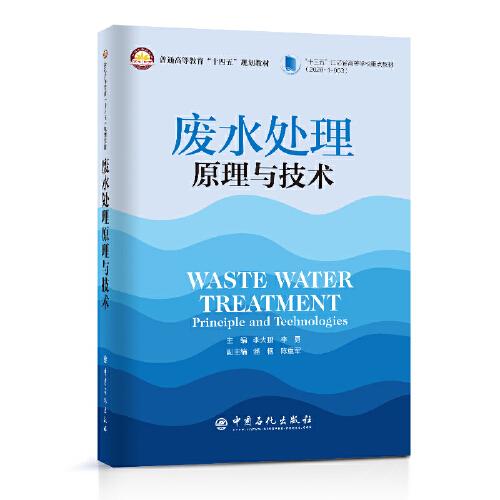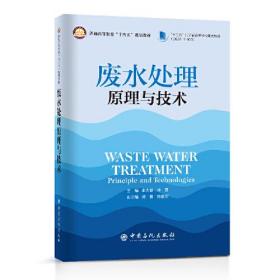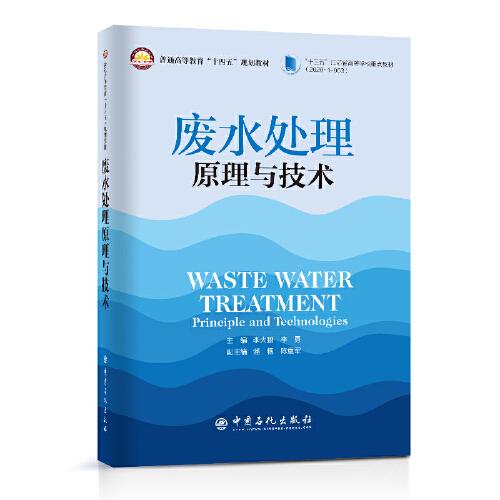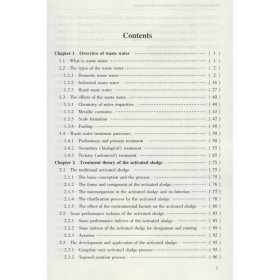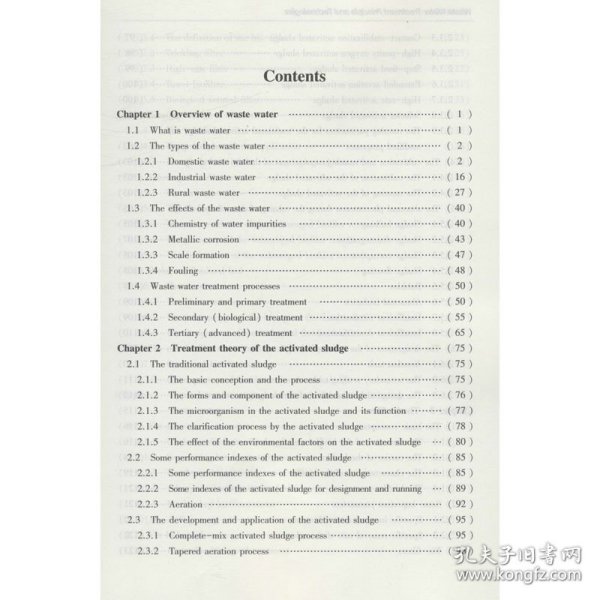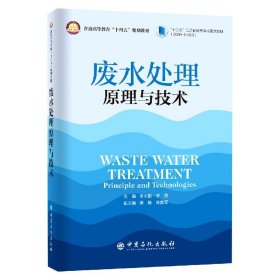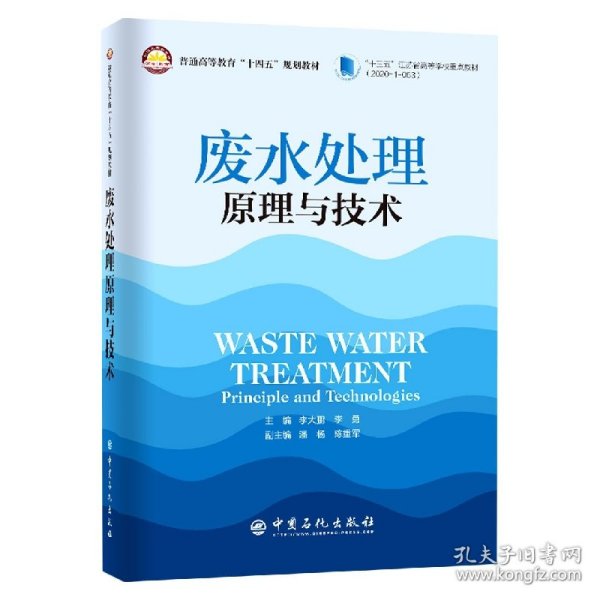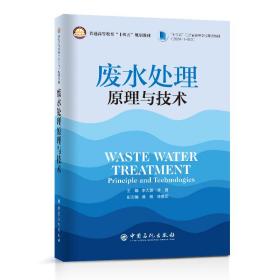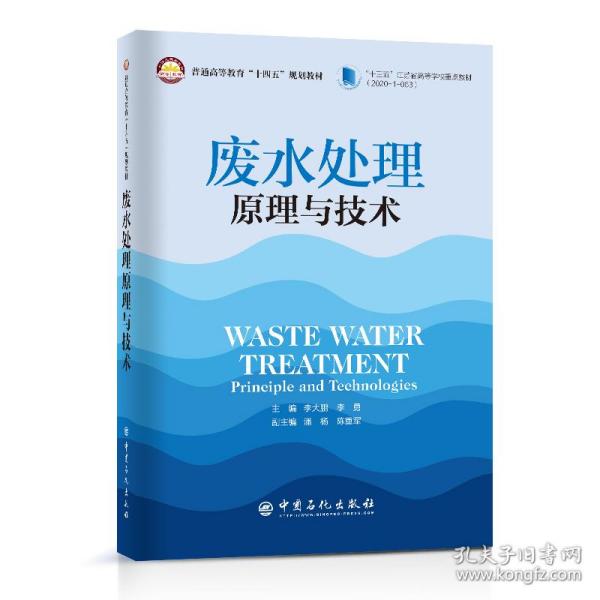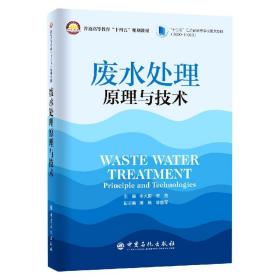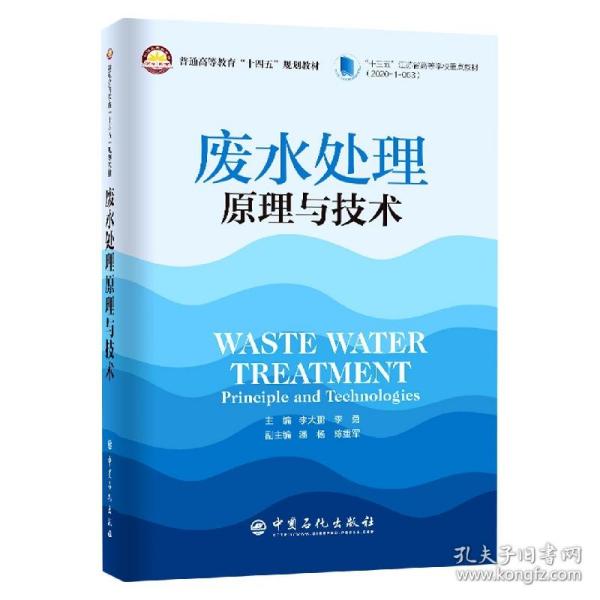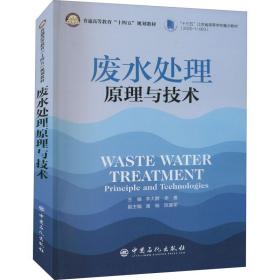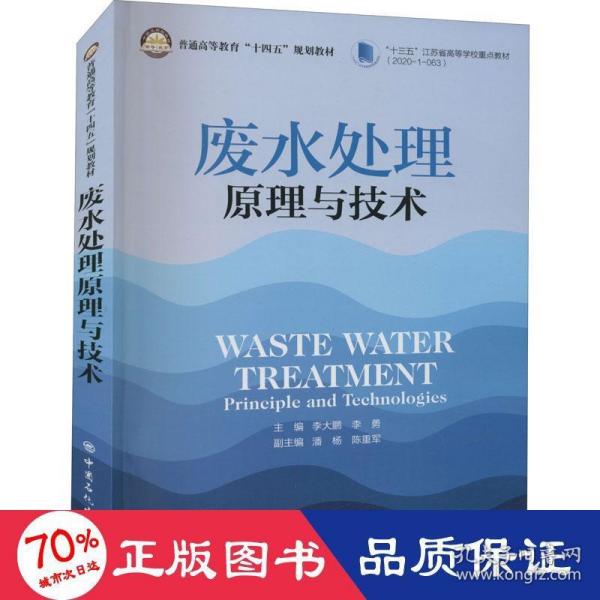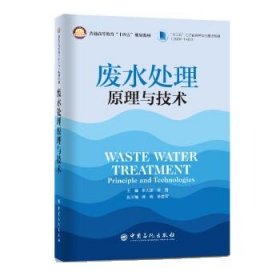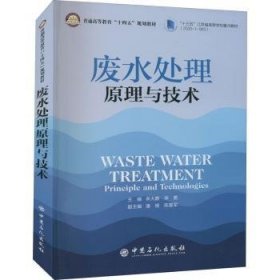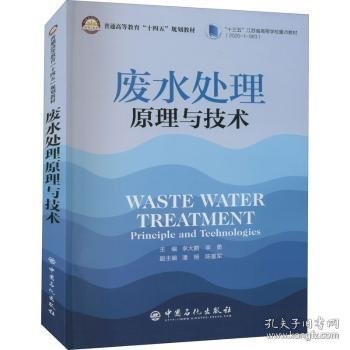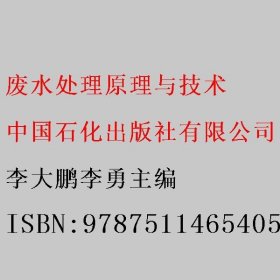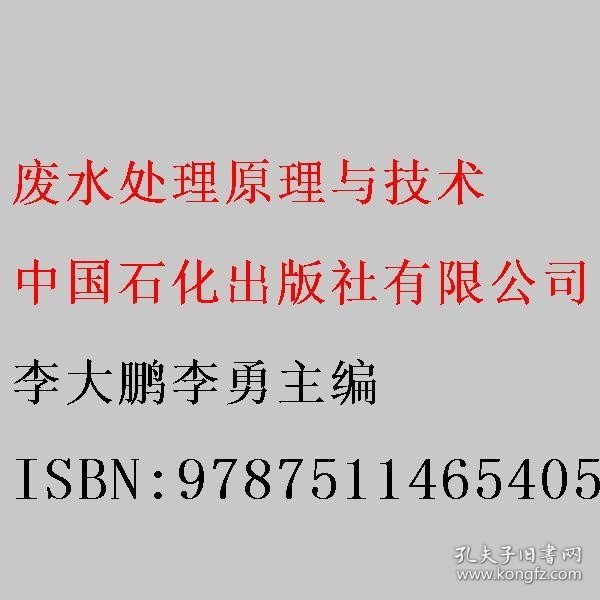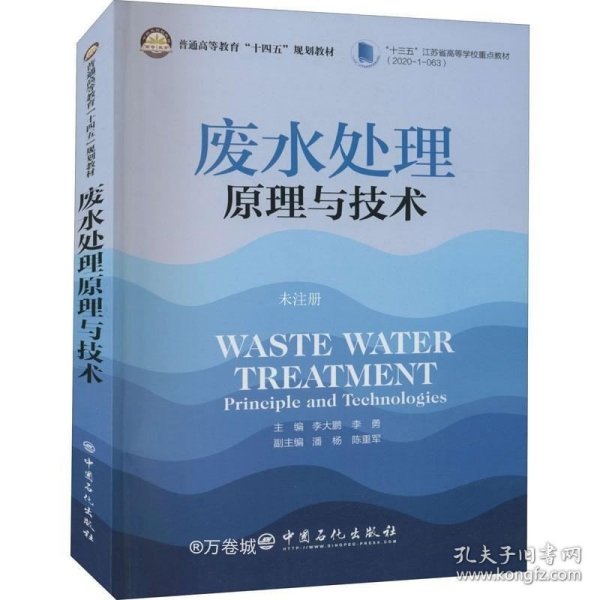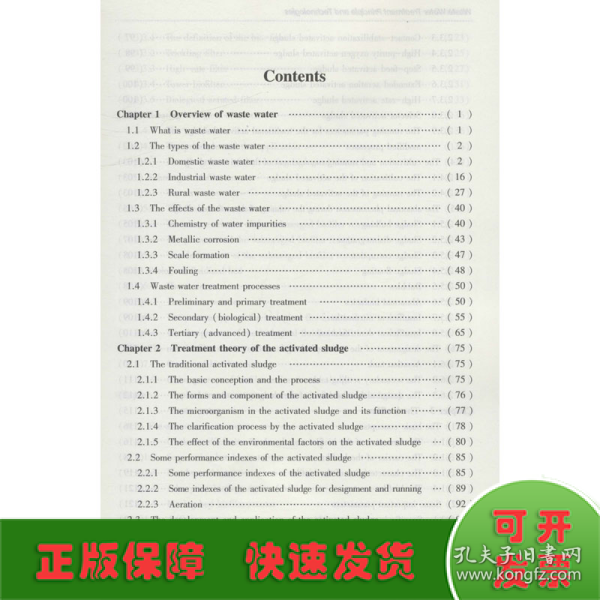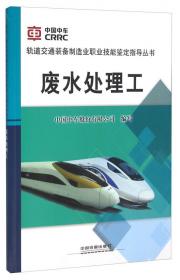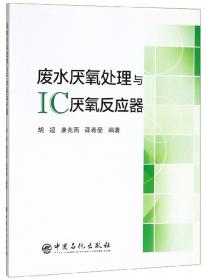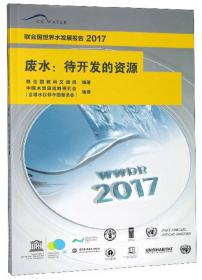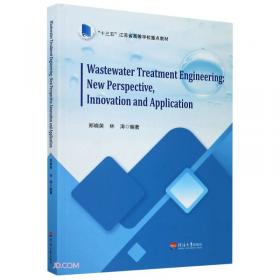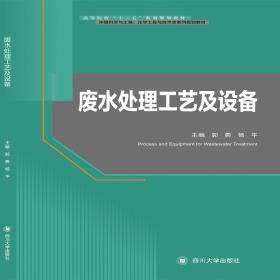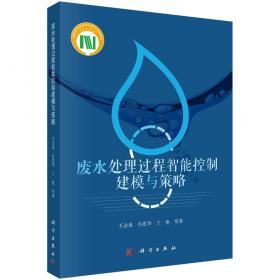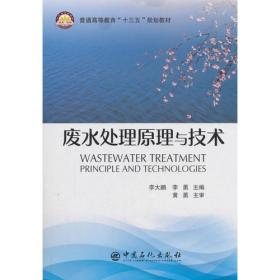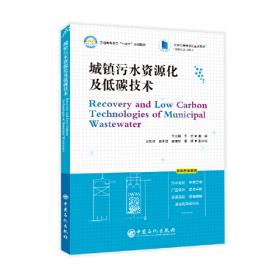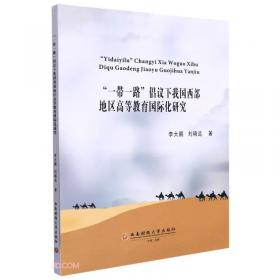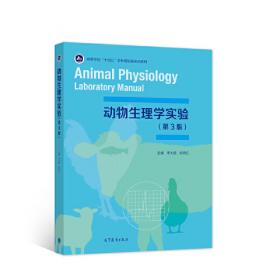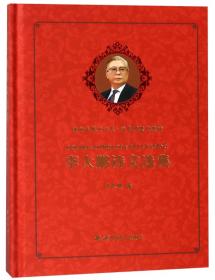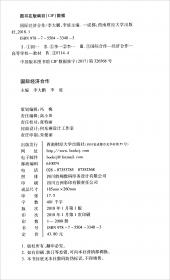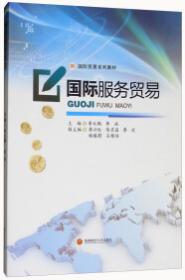废水处理原理与技术
出版时间:
2022-04
版次:
1
ISBN:
9787511465405
定价:
68.00
装帧:
平装
开本:
16开
纸张:
胶版纸
页数:
367页
字数:
389.000千字
-
本书系统介绍了各种水处理单元技术方法的基本原理、工艺流程、设计计算、管理及应用等。内容包括总论、筛滤与调节、混凝、沉淀与上浮、深层过滤、化学处理、吸附、离子交换、膜分离、其他相转移分离法、循环冷却水处理、废水生物处理理论基础、好氧活性污泥法、好氧生物膜法、厌氧生物处理、生物脱氮除磷、人工生态处理、污泥处理与处置、废水处理厂设计等。 李大鹏,男,46岁,苏州科技大学/省协同创新中心管委会办公室主任/教授,高等教育给排水科学与工程专业评估委员会委员,专业方向:农村生活污水处理,地表水修复/访问学者1年,为国际留学生全英文授课4年。主持完成国家自然科学基金3项,主持完成省部级项目3项,参与完成国家自然科学基金重点项目1项和“十一五”水重大专项1项;目前主持国家自然科学基金1项、“十三五”水重大专项子课题2项、省高校重大项目1项。参编《湖泊沉积物界面过程与效应》,2013年,科学出版社,独立撰写第10章,4万字。迄今,公开发表文章102篇,其中SCI6篇(1区1篇,2区3篇),EI15篇,CSCD收录31篇。 Chapter 1 Overview of waste water ( 1 ) 1.1 What is waste water ( 1 ) 1.2 The types of the waste water ( 2 ) 1.2.1 Domestic waste water ( 2 ) 1.2.2 Industrial waste water ( 16 ) 1.2.3 Rural waste water ( 27 ) 1.3 The effects of the waste water ( 40 ) 1.3.1 Chemistry of water impurities ( 40 ) 1.3.2 Metallic corrosion ( 43 ) 1.3.3 Scale formation ( 47 ) 1.3.4 Fouling ( 48 ) 1.4 Waste water treatment processes ( 50 ) 1.4.1 Preliminary and primary treatment ( 50 ) 1.4.2 Secondary (biological) treatment ( 55 ) 1.4.3 Tertiary (advanced) treatment ( 65 )Chapter 2 Treatment theory of the activated sludge ( 75 ) 2.1 The traditional activated sludge ( 75 ) 2.1.1 The basic conception and the process ( 75 ) 2.1.2 The forms and component of the activated sludge ( 76 ) 2.1.3 The microorganism in the activated sludge and its function ( 77 ) 2.1.4 The clarification process by the activated sludge ( 78 ) 2.1.5 The effect of the environmental factors on the activated sludge ( 80 ) 2.2 Some performance indexes of the activated sludge ( 85 ) 2.2.1 Some performance indexes of the activated sludge ( 85 ) 2.2.2 Some indexes of the activated sludge for designment and running ( 89 ) 2.2.3 Aeration ( 92 ) 2.3 The development and application of the activated sludge ( 95 ) 2.3.1 Complete-mix activated sludge process ( 95 )2.3.2 Tapered aeration process ( 96 )2.3.3 Contact-stabilization activated sludge ( 97 ) 2.3.4 High-purity oxygen activated sludge ( 98 ) 2.3.5 Step-feed activated sludge ( 99 ) 2.3.6 Extended aeration activated sludge (100) 2.3.7 High-rate activated sludge (100) 2.3.8 Selector activated sludge (101) 2.3.9 The running parameters for the traditional activated sludge andmodified processes (102) 2.4 The cultivation and running management of the activated sludge (103) 2.4.1 The cultivation of the activated sludge (103) 2.4.2 The running of the activated sludge (103) 2.5 The abnormal phenomenon during the running of the activated sludge (105) 2.5.1 Sludge bulking (105) 2.5.2 Sludge disintegration (107) 2.5.3 Sludge corruption (108) 2.5.4 Sludge floating (108) 2.5.5 Bubbles (108) 2.5.6 Abnormal biofacies (109) 2.5.7 Insufficient nitrification (109) 2.5.8 Insufficient denitrification (110) 2.6 The designment of the activated sludge (110) 2.6.1 Aeration tank (110) 2.6.2 The secondary settling tank (111) 2.6.3 The design on the backflow of the sludge (112)Chapter 3 The biofilm (115) 3.1 The basic concepts (116) 3.1.1 The formation of the biofilm and the clarification (116) 3.1.2 The carrier of the biofilm (118) 3.1.3 The characteristics of the biofilm (119) 3.1.4 The biofilm reactor (121) 3.2 Some important parameters (121) 3.2.1 Specific increase rate of biomass (122) 3.2.2 Specific removal rate of the substrate (122) 3.3 Bio-filters (123)3.3.1 The definition of the bio-filter (123 ) 3.3.2 Trickling filter (125) 3.3.3 High-rate filter (127) 3.3.4 Tower biofilter (131) 3.3.5 Biological aerated filter (133) 3.4 Rotating biological contactor (136) 3.4.1 The overview (136) 3.4.2 The principle and the application (136) 3.4.3 The designment of the rotating biological contactor (139) 3.5 Submerged biofilm reactor (140) 3.5.1 The structure (141) 3.5.2 The form of the aeration tank (142) 3.5.3 The characteristics of the submerged biofilm reactor (144) 3.5.4 The processes of the submerged biofilm reactor (144) 3.5.5 The designment of the submerged biofilm reactor (146) 3.6 Biological fluidized bed (147) 3.6.1 The structure (147) 3.6.2 The characteristics u56256 ._xddba_ (148) 3.6.3 The process type of the biological fluidized bed (149) 3.6.4 The designment of the biological fluidized bed (151) 3.7 The new biofilm reactor and combination process (152) 3.7.1 Combined biofilm reactor (152) 3.7.2 Union process of biofilm and activated sludge (153)Chapter 4 Typical treatment processes on domestic and industrywaste water (156) 4.1 For domestic waste water (156) 4.1.1 Oxidation ditch (156) 4.1.2 Sequencing batch reactor (171) 4.1.3 Membrane bioreactor (183) 4.1.4 Adsorption biodegradation (AB) (186) 4.1.5 Moving bed biofilm reactor (188) 4.1.6 A/ O process (190) 4.2 For Industrial waste water (206) 4.2.1 Anaerobic biological treatment (207)4.2.2 Upflow anaerobic sludge blanket reactor (216 ) 4.2.3 The other typical technologies (218)Chapter 5 Typical technology on rural waste water (227) 5.1 Production and collection of rural domestic waste water (227) 5.1.1 Production of rural domestic waste water (227) 5.1.2 Collection of rural domestic waste water (228) 5.1.3 Water quality characteristics of rural domestic waste water (230) 5.2 Typical technologies (231) 5.2.1 Oxidation lagoon (231) 5.2.2 The wetlands (241) 5.3 Commonly used integrated treatment device for rural domesticsewage treatment (246) 5.3.1 Vertical flow type AAO integrated device (246) 5.3.2 Integrated air lift SBR device (247) 5.3.3 Integrated biological filter (249) 5.3.4 Integrated MBR device (250) 5.4 Long-term operation and management mechanism of rural waste watertreatment technology (251)5.4.1 Territory (village and town) self-operation and maintenancemanagement mechanism (251) 5.4.2 Third-party operation management mechanism (251) 5.4.3 Construction and operation integrated operation managementmechanism (252)Chapter 6 Control and use on sludge (254) 6.1 Overview (254) 6.1.1 The principle for the sludge treatment (254) 6.1.2 The basic method for the sludge treatment (255) 6.1.3 The basic process for the sludge treatment (256) 6.2 Sludge characteristics and calculation (256) 6.2.1 The component and the types of the sludge (256) 6.2.2 The indexes of the sludge (257) 6.2.3 The calculation on the sludge amount (260) 6.3 Sludge thickening (261) 6.3.1 The gravity thickening (262)6.3.2 The flotation thickening (263 ) 6.4 Sludge digestion (264) 6.4.1 Anaerobic digestion (264) 6.4.2 Aerobic digestion (265) 6.5 Sludge conditioning (265) 6.5.1 Chemical conditioning (266) 6.5.2 Heat conditioning (266) 6.5.3 Elutriation conditioning (266) 6.5.4 Freezing solution conditioning (267) 6.6 Sludge dewatering (267) 6.6.1 The natural drying of sludge (267) 6.6.2 The mechanical dewatering of sludge (267) 6.7 Sludge drying and incineration (270) 6.8 Comprehensive utilization and ultimate disposal of the sludge (270) 6.8.1 Agricultural fertilizer (270) 6.8.2 Building materials (271) 6.8.3 Landfill (271) 6.8.4 Land use (271) 6.8.5 Compost (272) 6.8.6 Thermolysis (273)Chapter 7 Waste water treatment cases (275) 7.1 Traditional activated sludge (276) 7.2 Anaerobic-aerobic activated sludge process (277) 7.2.1 Anaerobic-aerobic activated sludge process for removal P (277) 7.2.2 Anaerobic/ anoxic/ aerobic process (278) 7.3 Adsorption/ biodegradation process (278) 7.4 Oxidation ditch process (280) 7.4.1 A-E oxidation ditch (280) 7.4.2 T oxidation ditch (282) 7.5 Biological aerated filter (284) 7.6 A domestic example of reconstruction and extension of sewage plant (285) 7.6.1 Introduction (285) 7.6.2 Renovation and extension scheme of sewage plant (289) 7.6.3 Operation effect (319)Chapter 8 Water reclamation and reuse (320 ) 8.1 Water reclamation (321) 8.2 Current and potential future global water shortages (324) 8.2.1 Irrigation water use (324) 8.2.2 Domestic and industrial water uses (325) 8.3 The important role of the water reclamation and reuse (325) 8.4 Technology development (330) 8.4.1 Typical water reclamation processes (332) 8.4.2 Complete flow scheme optimizing for water reuse (334) 8.5 Framework for water reuse implementation (338) 8.6 Cases (339) 8.6.1 Water reuse in China (339) 8.6.2 The others (350)Chapter 9 Waste water recovery (358) 9.1 What is waste water recovery (358) 9.1.1 Pollutant recovery (358) 9.1.2 Water reuse (359) 9.2 Recovery and energy in municipal waste water (360) 9.2.1 Recovery types and feasibility (360) 9.2.2 Energy reserves and energy feasibility (361) 9.3 Phosphorus recovery (362) 9.3.1 Significance of phosphorus recovery (362) 9.3.2 Basic methods for phosphorus resource (363) 9.3.3 Evaluation on phosphorus resource (366)
-
内容简介:
本书系统介绍了各种水处理单元技术方法的基本原理、工艺流程、设计计算、管理及应用等。内容包括总论、筛滤与调节、混凝、沉淀与上浮、深层过滤、化学处理、吸附、离子交换、膜分离、其他相转移分离法、循环冷却水处理、废水生物处理理论基础、好氧活性污泥法、好氧生物膜法、厌氧生物处理、生物脱氮除磷、人工生态处理、污泥处理与处置、废水处理厂设计等。
-
作者简介:
李大鹏,男,46岁,苏州科技大学/省协同创新中心管委会办公室主任/教授,高等教育给排水科学与工程专业评估委员会委员,专业方向:农村生活污水处理,地表水修复/访问学者1年,为国际留学生全英文授课4年。主持完成国家自然科学基金3项,主持完成省部级项目3项,参与完成国家自然科学基金重点项目1项和“十一五”水重大专项1项;目前主持国家自然科学基金1项、“十三五”水重大专项子课题2项、省高校重大项目1项。参编《湖泊沉积物界面过程与效应》,2013年,科学出版社,独立撰写第10章,4万字。迄今,公开发表文章102篇,其中SCI6篇(1区1篇,2区3篇),EI15篇,CSCD收录31篇。
-
目录:
Chapter 1 Overview of waste water ( 1 ) 1.1 What is waste water ( 1 ) 1.2 The types of the waste water ( 2 ) 1.2.1 Domestic waste water ( 2 ) 1.2.2 Industrial waste water ( 16 ) 1.2.3 Rural waste water ( 27 ) 1.3 The effects of the waste water ( 40 ) 1.3.1 Chemistry of water impurities ( 40 ) 1.3.2 Metallic corrosion ( 43 ) 1.3.3 Scale formation ( 47 ) 1.3.4 Fouling ( 48 ) 1.4 Waste water treatment processes ( 50 ) 1.4.1 Preliminary and primary treatment ( 50 ) 1.4.2 Secondary (biological) treatment ( 55 ) 1.4.3 Tertiary (advanced) treatment ( 65 )Chapter 2 Treatment theory of the activated sludge ( 75 ) 2.1 The traditional activated sludge ( 75 ) 2.1.1 The basic conception and the process ( 75 ) 2.1.2 The forms and component of the activated sludge ( 76 ) 2.1.3 The microorganism in the activated sludge and its function ( 77 ) 2.1.4 The clarification process by the activated sludge ( 78 ) 2.1.5 The effect of the environmental factors on the activated sludge ( 80 ) 2.2 Some performance indexes of the activated sludge ( 85 ) 2.2.1 Some performance indexes of the activated sludge ( 85 ) 2.2.2 Some indexes of the activated sludge for designment and running ( 89 ) 2.2.3 Aeration ( 92 ) 2.3 The development and application of the activated sludge ( 95 ) 2.3.1 Complete-mix activated sludge process ( 95 )2.3.2 Tapered aeration process ( 96 )2.3.3 Contact-stabilization activated sludge ( 97 ) 2.3.4 High-purity oxygen activated sludge ( 98 ) 2.3.5 Step-feed activated sludge ( 99 ) 2.3.6 Extended aeration activated sludge (100) 2.3.7 High-rate activated sludge (100) 2.3.8 Selector activated sludge (101) 2.3.9 The running parameters for the traditional activated sludge andmodified processes (102) 2.4 The cultivation and running management of the activated sludge (103) 2.4.1 The cultivation of the activated sludge (103) 2.4.2 The running of the activated sludge (103) 2.5 The abnormal phenomenon during the running of the activated sludge (105) 2.5.1 Sludge bulking (105) 2.5.2 Sludge disintegration (107) 2.5.3 Sludge corruption (108) 2.5.4 Sludge floating (108) 2.5.5 Bubbles (108) 2.5.6 Abnormal biofacies (109) 2.5.7 Insufficient nitrification (109) 2.5.8 Insufficient denitrification (110) 2.6 The designment of the activated sludge (110) 2.6.1 Aeration tank (110) 2.6.2 The secondary settling tank (111) 2.6.3 The design on the backflow of the sludge (112)Chapter 3 The biofilm (115) 3.1 The basic concepts (116) 3.1.1 The formation of the biofilm and the clarification (116) 3.1.2 The carrier of the biofilm (118) 3.1.3 The characteristics of the biofilm (119) 3.1.4 The biofilm reactor (121) 3.2 Some important parameters (121) 3.2.1 Specific increase rate of biomass (122) 3.2.2 Specific removal rate of the substrate (122) 3.3 Bio-filters (123)3.3.1 The definition of the bio-filter (123 ) 3.3.2 Trickling filter (125) 3.3.3 High-rate filter (127) 3.3.4 Tower biofilter (131) 3.3.5 Biological aerated filter (133) 3.4 Rotating biological contactor (136) 3.4.1 The overview (136) 3.4.2 The principle and the application (136) 3.4.3 The designment of the rotating biological contactor (139) 3.5 Submerged biofilm reactor (140) 3.5.1 The structure (141) 3.5.2 The form of the aeration tank (142) 3.5.3 The characteristics of the submerged biofilm reactor (144) 3.5.4 The processes of the submerged biofilm reactor (144) 3.5.5 The designment of the submerged biofilm reactor (146) 3.6 Biological fluidized bed (147) 3.6.1 The structure (147) 3.6.2 The characteristics u56256 ._xddba_ (148) 3.6.3 The process type of the biological fluidized bed (149) 3.6.4 The designment of the biological fluidized bed (151) 3.7 The new biofilm reactor and combination process (152) 3.7.1 Combined biofilm reactor (152) 3.7.2 Union process of biofilm and activated sludge (153)Chapter 4 Typical treatment processes on domestic and industrywaste water (156) 4.1 For domestic waste water (156) 4.1.1 Oxidation ditch (156) 4.1.2 Sequencing batch reactor (171) 4.1.3 Membrane bioreactor (183) 4.1.4 Adsorption biodegradation (AB) (186) 4.1.5 Moving bed biofilm reactor (188) 4.1.6 A/ O process (190) 4.2 For Industrial waste water (206) 4.2.1 Anaerobic biological treatment (207)4.2.2 Upflow anaerobic sludge blanket reactor (216 ) 4.2.3 The other typical technologies (218)Chapter 5 Typical technology on rural waste water (227) 5.1 Production and collection of rural domestic waste water (227) 5.1.1 Production of rural domestic waste water (227) 5.1.2 Collection of rural domestic waste water (228) 5.1.3 Water quality characteristics of rural domestic waste water (230) 5.2 Typical technologies (231) 5.2.1 Oxidation lagoon (231) 5.2.2 The wetlands (241) 5.3 Commonly used integrated treatment device for rural domesticsewage treatment (246) 5.3.1 Vertical flow type AAO integrated device (246) 5.3.2 Integrated air lift SBR device (247) 5.3.3 Integrated biological filter (249) 5.3.4 Integrated MBR device (250) 5.4 Long-term operation and management mechanism of rural waste watertreatment technology (251)5.4.1 Territory (village and town) self-operation and maintenancemanagement mechanism (251) 5.4.2 Third-party operation management mechanism (251) 5.4.3 Construction and operation integrated operation managementmechanism (252)Chapter 6 Control and use on sludge (254) 6.1 Overview (254) 6.1.1 The principle for the sludge treatment (254) 6.1.2 The basic method for the sludge treatment (255) 6.1.3 The basic process for the sludge treatment (256) 6.2 Sludge characteristics and calculation (256) 6.2.1 The component and the types of the sludge (256) 6.2.2 The indexes of the sludge (257) 6.2.3 The calculation on the sludge amount (260) 6.3 Sludge thickening (261) 6.3.1 The gravity thickening (262)6.3.2 The flotation thickening (263 ) 6.4 Sludge digestion (264) 6.4.1 Anaerobic digestion (264) 6.4.2 Aerobic digestion (265) 6.5 Sludge conditioning (265) 6.5.1 Chemical conditioning (266) 6.5.2 Heat conditioning (266) 6.5.3 Elutriation conditioning (266) 6.5.4 Freezing solution conditioning (267) 6.6 Sludge dewatering (267) 6.6.1 The natural drying of sludge (267) 6.6.2 The mechanical dewatering of sludge (267) 6.7 Sludge drying and incineration (270) 6.8 Comprehensive utilization and ultimate disposal of the sludge (270) 6.8.1 Agricultural fertilizer (270) 6.8.2 Building materials (271) 6.8.3 Landfill (271) 6.8.4 Land use (271) 6.8.5 Compost (272) 6.8.6 Thermolysis (273)Chapter 7 Waste water treatment cases (275) 7.1 Traditional activated sludge (276) 7.2 Anaerobic-aerobic activated sludge process (277) 7.2.1 Anaerobic-aerobic activated sludge process for removal P (277) 7.2.2 Anaerobic/ anoxic/ aerobic process (278) 7.3 Adsorption/ biodegradation process (278) 7.4 Oxidation ditch process (280) 7.4.1 A-E oxidation ditch (280) 7.4.2 T oxidation ditch (282) 7.5 Biological aerated filter (284) 7.6 A domestic example of reconstruction and extension of sewage plant (285) 7.6.1 Introduction (285) 7.6.2 Renovation and extension scheme of sewage plant (289) 7.6.3 Operation effect (319)Chapter 8 Water reclamation and reuse (320 ) 8.1 Water reclamation (321) 8.2 Current and potential future global water shortages (324) 8.2.1 Irrigation water use (324) 8.2.2 Domestic and industrial water uses (325) 8.3 The important role of the water reclamation and reuse (325) 8.4 Technology development (330) 8.4.1 Typical water reclamation processes (332) 8.4.2 Complete flow scheme optimizing for water reuse (334) 8.5 Framework for water reuse implementation (338) 8.6 Cases (339) 8.6.1 Water reuse in China (339) 8.6.2 The others (350)Chapter 9 Waste water recovery (358) 9.1 What is waste water recovery (358) 9.1.1 Pollutant recovery (358) 9.1.2 Water reuse (359) 9.2 Recovery and energy in municipal waste water (360) 9.2.1 Recovery types and feasibility (360) 9.2.2 Energy reserves and energy feasibility (361) 9.3 Phosphorus recovery (362) 9.3.1 Significance of phosphorus recovery (362) 9.3.2 Basic methods for phosphorus resource (363) 9.3.3 Evaluation on phosphorus resource (366)
查看详情
-
废水处理原理与技术、
全新正版书籍,假一罚十(图片为标准图,仅供参考。以标题为准,不了解的可以询问客服。) 可开发票
全新
北京市朝阳区
平均发货16小时
成功完成率96.15%
-
#废水处理原理与技术
正版库存一手书,品相视出版时间长短而定,自然成色,可开电子发票,图片由软件自动采集,以书名为准,不以图片不符售后!
全新
山东省泰安市
平均发货8小时
成功完成率93.19%
-
九品
北京市海淀区
平均发货24小时
成功完成率86.39%
-
全新
四川省成都市
平均发货9小时
成功完成率96.98%
-
废水处理原理与技术
部分图书软件采集的图片与文字介绍不符,请以文字描述为准,自动忽略图片。
全新
河北省保定市
平均发货33小时
成功完成率66.17%
-
全新
北京市房山区
平均发货29小时
成功完成率83.68%
-
全新
山东省泰安市
平均发货24小时
成功完成率92.34%
-
全新
天津市西青区
平均发货14小时
成功完成率90.27%
-
全新
天津市津南区
平均发货13小时
成功完成率94.5%
-
全新
北京市房山区
平均发货15小时
成功完成率81.87%
-
全新
广东省广州市
平均发货20小时
成功完成率87.58%
-
全新
四川省成都市
平均发货24小时
成功完成率86.17%
-
全新
河北省保定市
平均发货27小时
成功完成率80.38%
-
全新
北京市西城区
平均发货28小时
成功完成率88.77%
-
全新
北京市房山区
平均发货25小时
成功完成率87.26%
-
废水处理原理与技术
所有图书均为正版新书,库存书,ISBN匹配图片偶尔会有误差,订单以ISBN码为准,套装@合集价格低的实为单本,版本有疑问先咨询下再下单
全新
四川省成都市
平均发货32小时
成功完成率70.63%
-
九五品
河北省保定市
平均发货20小时
成功完成率80.78%
-
全新
山东省济宁市
平均发货67小时
成功完成率81.29%
-
九五品
河北省保定市
平均发货15小时
成功完成率84.71%
-
全新
河北省保定市
平均发货26小时
成功完成率90.4%
-
废水处理原理与技术(
全新正版书籍,假一罚十(图片为标准图,仅供参考。以标题为准,不了解的可以询问客服。) 可开发票
全新
北京市朝阳区
平均发货16小时
成功完成率96.15%
-
九五品
江苏省无锡市
平均发货16小时
成功完成率79.96%
-
全新
山东省泰安市
平均发货24小时
成功完成率92.34%
-
废水处理原理与技术(
全新正版书籍,假一罚十(图片为标准图,仅供参考。以标题为准,不了解的可以询问客服。) 可开发票
全新
北京市朝阳区
平均发货18小时
成功完成率94.92%
-
全新
江苏省苏州市
平均发货9小时
成功完成率95.6%
-
全新
江苏省南京市
平均发货15小时
成功完成率83.08%
-
全新
北京市丰台区
平均发货23小时
成功完成率88.43%
-
全新
江苏省无锡市
平均发货17小时
成功完成率87.2%
-
废水处理原理与技术
重要提醒:::重要提醒::所有图书保证正版,按书名发货图片仅供参考, 有疑问请咨询客服,看清书名按书名发货
全新
北京市通州区
平均发货9小时
成功完成率89.37%
-
全新
四川省成都市
平均发货15小时
成功完成率90.89%
-
全新
天津市河北区
平均发货43小时
成功完成率81.4%
-
全新
北京市丰台区
平均发货8小时
成功完成率90.55%
-
全新
北京市西城区
平均发货28小时
成功完成率90.58%
-
全新
上海市黄浦区
平均发货11小时
成功完成率94.39%
-
全新
北京市朝阳区
平均发货20小时
成功完成率84.57%
-
全新
山东省泰安市
平均发货18小时
成功完成率92.79%
-
八五品
四川省成都市
平均发货12小时
成功完成率91.55%
-
全新
浙江省嘉兴市
平均发货10小时
成功完成率94.14%
-
全新
广东省广州市
平均发货8小时
成功完成率94.72%
-
全新
北京市通州区
平均发货11小时
成功完成率94.01%
-
全新
江苏省无锡市
平均发货18小时
成功完成率94.5%
-
全新
天津市河东区
平均发货28小时
成功完成率90.53%
-
全新
山东省泰安市
平均发货23小时
成功完成率86.14%
-
全新
北京市东城区
平均发货29小时
成功完成率84.72%
-
全新
山东省泰安市
平均发货23小时
成功完成率86.14%
-
全新
江苏省无锡市
平均发货8小时
成功完成率95.88%
-
全新
江苏省无锡市
平均发货18小时
成功完成率94.5%
-
全新
江苏省南京市
平均发货7小时
成功完成率98.16%
-
全新
北京市朝阳区
平均发货9小时
成功完成率96.85%
-
全新
江苏省无锡市
平均发货10小时
成功完成率93.42%

 占位居中
占位居中

